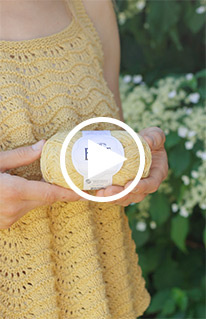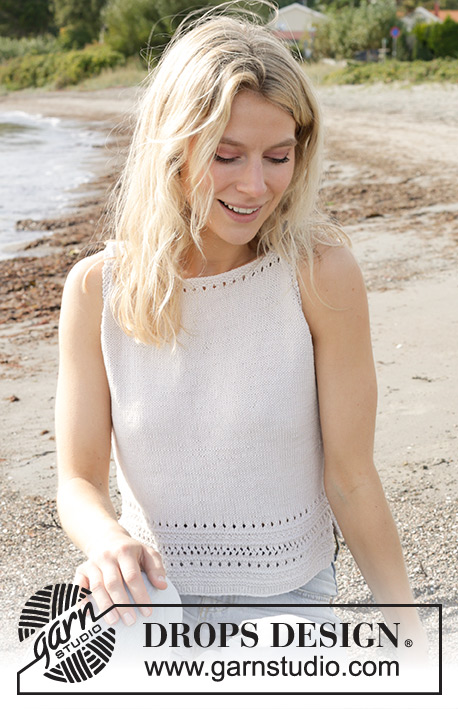Comments / Questions (15)
![]() Cinzia wrote:
Cinzia wrote:
Buongiorno, potrei sapere la modella che taglia indossa? Grazie
06.07.2025 - 10:25
![]() Canary Belle Top/Drops 240 - 13 wrote:
Canary Belle Top/Drops 240 - 13 wrote:
Jeg er ved at strikke Canary Belle Top 240 - 13. Da jeg var færdig med A.1 Har jeg 107 masker, ifølge opskriften skal der være 101 maske. Hvad gør jeg forkert.
29.06.2025 - 17:08DROPS Design answered:
Hei Canary. Mulig du har økt litt for mye. Om du strikker str. S/M skal du ha 54 masker når du har strikket de 2 delene sammen (8+8) + lagt opp 36 masker = 54 masker. Så økes det med 5 masker = 59 masker. Så strikkes det 5 masker i riller + A.1 (strikk A.1 = 7 masker som strikkes 7 ganger = 49 masker) + 5 masker i riller = 59 masker. Når du har strikket A.1 1 gang i høyden har du også økt med 6 masker hver gang A.1 strikkes. Da blir det 5 masker i riller + A.1 (som nå består av 13 masker x 7 ganger = 91 masker) + 5 masker i riller = 5+91+5= 101 masker. mvh DROPS Design
30.06.2025 - 15:15
![]() Lene wrote:
Lene wrote:
Jeg er ved at strikke en top med bølgemønster, og skal til at tage ud I mønster A.1 Hvordan gør jeg det
22.06.2025 - 07:35DROPS Design answered:
Hei Lena. Jo, ta en titt på diagrammet, så ser du at i A.1 øker du masker på 5. + 11. + 17. omgang. Det økes med 2 masker hver gang diagrammet strikkes, tilsammen 6 økte masker i høyden x antall diagrammet strikkes i bredden. mvh DROPS Design
23.06.2025 - 14:13
![]() Minna Soirio wrote:
Minna Soirio wrote:
Jag ser diagram bara fram till A.3, men i mönstret står det att det ska finnas till A.10. Ska jag köpa resten och var kan jag göra det i sånna fall?
23.05.2023 - 16:12DROPS Design answered:
Hej Minna, alle diagrammer ligger nederst i opskriften og er helt gratis. Du finder dem lige ovenfor måleskitsen nederst :)
24.05.2023 - 07:24
![]() Silvia wrote:
Silvia wrote:
Hola: en la descripción del patrón se relacionan 6 tallas pero en el dibujo sólo hay 5 tallas ¿cómo es la correspondencia de talla del patrón y las medidas del dibijo? Muchas gracias
04.05.2023 - 09:11DROPS Design answered:
Hola Silvia, solo hay 5 tallas: XS - S/M - L - XL - XXL. La talla S/M es una talla intermedia entre ambas, y no dos tallas separadas. Por lo tanto, cada medida del dibujo se corresponde a una de las tallas. Para más información, puedes leer la siguiente lección: https://www.garnstudio.com/lesson.php?id=24&cid=23
07.05.2023 - 13:06
![]() Jennifer Carvalho wrote:
Jennifer Carvalho wrote:
Is there a pattern for a sweater with a back elevation? Thank you
26.04.2023 - 14:38DROPS Design answered:
Dear Mrs Carvalho, sure we do, but there is no tag for this, so that you might have to check our patterns for jumpers worked top down (in the requested tension/type) to check if they do have an elevation on mid back. Happy knitting!
26.04.2023 - 16:38
![]() Gleena Goriel wrote:
Gleena Goriel wrote:
Summer holiday, summer breeze
19.01.2023 - 20:13
![]() Me wrote:
Me wrote:
Sunny waves
19.01.2023 - 16:32
![]() Kari Little wrote:
Kari Little wrote:
Golden Sands
19.01.2023 - 10:21
![]() Elisabeth wrote:
Elisabeth wrote:
Golden Hour
18.01.2023 - 19:58
Canary Belle Top#canarybelletop |
|||||||||||||
 |
 |
||||||||||||
Knitted top in DROPS Belle. The piece is worked top down with wave-pattern. Sizes XS - XXL.
DROPS 240-13 |
|||||||||||||
|
------------------------------------------------------- EXPLANATIONS FOR THE PATTERN: ------------------------------------------------------- RIDGE/GARTER STITCH (worked in the round): 1 ridge in height = 2 rounds; Knit 1 round and purl 1 round. RIDGE/GARTER STITCH (worked back and forth): Knit all rows. 1 ridge = knit 2 rows. PATTERN: See diagrams A.1 to A.10. The diagrams show all rows in the pattern from the right side. ------------------------------------------------------- START THE PIECE HERE: ------------------------------------------------------- TOP – SHORT OVERVIEW OF THE PIECE: The front and back pieces are started separately back and forth, top down. The pieces are joined and continued in the round. FRONT PIECE: Right shoulder: Cast on 8-9-10-11-11 stitches with circular needle size 4 MM = US 6 and DROPS Belle. Work GARTER STITCH back and forth – read description above, until the piece measures 7-7-8-8-9 cm = 2¾"-2¾"-3⅛"-3⅛"-3½" – finish with a row from the wrong side, Cut the strand. Lay the piece to one side. Left shoulder: Cast on 8-9-10-11-11 stitches with circular needle size 4 MM = US 6 and DROPS Belle. Work garter stitch until the piece measures 7-7-8-8-9 cm = 2¾"-2¾"-3⅛"-3⅛"-3½" – finish with a row from the wrong side. Work the 2 pieces together as follows: Work the 8-9-10-11-11 stitches on the left shoulder, cast on 31-36-39-44-50 stitches at the end of the row for the neck, work the 8-9-10-11-11 stitches on the right shoulder = 47-54-59-66-72 stitches. Work 3 ridges over all stitches and, on the last row, increase 5-5-7-7-8 stitches evenly spaced = 52-59-66-73-80 stitches. Work the next row from the right side as follows: 5 garter stitches, A.1 until there are 5 stitches left, 5 garter stitches. Work and increase according to A.1. When A.1 is finished, there are 88-101-114-127-140 stitches (last row from wrong side). Continue with 5 garter stitches on each side and A.2 over A.1 until the piece measures 18-19-20-21-22 cm = 7"-7½"-8"-8¼"-8¾" from the cast-on edge, finishing with a row from the wrong side. Lay the piece to one side and work the back piece in the same way, finishing on the same row as the front piece. BODY: Now work the 2 pieces together: Work A.2 over the 88-101-114-127-140 stitches on the back piece, cast on 3 stitches, A.2 over the 88-101-114-127-140 stitches on the front piece, cast on 3 stitches = 182-208-234-260-286 stitches. Continue with A.2 over the wave-pattern on the front and back pieces and GARTER STITCH (in the round) – read description above, over the 13 stitches in each side. When you have worked 3 ridges in each side, work these stitches in A.2 (starting on the same round as the rest of the top). Continue with A.2. REMEMBER THE KNITTING GAUGE! When the piece measures 3 cm = 1⅛" from the join, work A.3 over all stitches. When A.3 is finished there are 238-272-306-340-374 stitches. Work A.4 2-2-2-2-2 times in height. Work A.5. When A.5 is finished there are 266-304-342-380-418 stitches. Work A.6 2-3-3-3-3 times in height. Work A.7. When A.7 is finished in height there are 294-336-378-420-462 stitches. Work A.8 2-2-3-3-3 times in height. Work A.9. When A.9 is finished in height there are 322-368-414-460-506 stitches. Work A.10 1-1-1-2-3 times in height. Work 1 ridge over all stitches. Bind off. The top measures approx. 46-49-52-55-58 cm = 18"-19¼"-20½"-21⅝"-22¾" from the shoulder. ASSEMBLY: Sew the straps together on each shoulder. |
|||||||||||||
Diagram explanations |
|||||||||||||
|
|||||||||||||

|
|||||||||||||

|
|||||||||||||

|
|||||||||||||
Have you finished this pattern?Tag your pictures with #dropspattern #canarybelletop or submit them to the #dropsfan gallery. Do you need help with this pattern?You'll find 19 tutorial videos, a Comments/Questions area and more by visiting the pattern on garnstudio.com. © 1982-2025 DROPS Design A/S. We reserve all rights. This document, including all its sub-sections, has copyrights. Read more about what you can do with our patterns at the bottom of each pattern on our site. |
|||||||||||||









































































Post a comment to pattern DROPS 240-13
We would love to hear what you have to say about this pattern!
If you want to leave a question, please make sure you select the correct category in the form below, to speed up the answering process. Required fields are marked *.